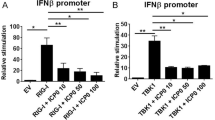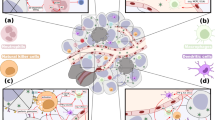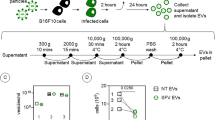Abstract
The oncotropic phenotypes of several viruses correlate with tumor-associated deficiencies within interferon (IFN) signaling pathways. This observation formed the conceptual basis for developing oncolytic viruses deleted for viral proteins that inhibit the host IFN-dependent antiviral response, such as herpes simplex virus type-1 infected cell protein-0 (ICP0) and vesicular stomatitis virus matrix protein. Many viruses have evolved means to disrupt promyelocytic leukemia protein (PML) nuclear bodies. For example, ICP0 promotes PML degradation to inhibit the antiviral activities of this IFN-stimulated gene. As PML is downregulated in a variety of tumors, we hypothesized ICP0-null herpes simplex type-1 viruses are selectively oncolytic in tumors with impaired PML expression. We illustrate that ICP0-null herpes simplex type-1 viruses target tumor cells that either possess impaired PML signaling or cannot upregulate PML because of impaired IFN responsiveness. Disruption of PML signaling through overexpression of the dominant-negative protein PML-retinoic acid receptor alpha in PML-positive cells renders them sensitive to oncolysis by ICP0-null herpes simplex virus type-1 and vesicular stomatitis virus M protein mutant viruses, whereas PML overexpression reverses this phenomenon. Together, these data illustrate that PML mediates an antiviral mechanism that predicts the tropism of IFN-sensitive oncolytic viruses. To our knowledge, these viruses are the first examples of anti-cancer therapeutics capable of targeting deficiencies in PML expression.
This is a preview of subscription content, access via your institution
Access options
Subscribe to this journal
Receive 6 print issues and online access
$259.00 per year
only $43.17 per issue
Buy this article
- Purchase on SpringerLink
- Instant access to full article PDF
Prices may be subject to local taxes which are calculated during checkout






Similar content being viewed by others
References
Lin E, Nemunaitis J . Oncolytic viral therapies. Cancer Gene Ther 2004; 11: 643–664.
Bell JC, Lichty B, Stojdl D . Getting oncolytic virus therapies off the ground. Cancer Cell 2003; 4: 7–11.
Sun WH, Pabon C, Alsayed Y, Huang PP, Jandeska S, Uddin S et al. Interferon-alpha resistance in a cutaneous T-cell lymphoma cell line is associated with lack of STAT1 expression. Blood 1998; 91: 570–576.
Wong LH, Krauer KG, Hatzinisiriou I, Estcourt MJ, Hersey P, Tam ND et al. Interferon-resistant human melanoma cells are deficient in ISGF3 components, STAT1, STAT2, and p48-ISGF3gamma. J Biol Chem 1997; 272: 28779–28785.
Takaoka A, Hayakawa S, Yanai H, Stoiber D, Negishi H, Kikuchi H et al. Integration of interferon-alpha/beta signalling to p53 responses in tumor suppression and antiviral defence. Nature 2003; 424: 516–523.
Silverman RH . Implications for RNase L in prostate cancer biology. Biochemistry 2003; 42: 1805–1812.
Stark GR, Kerr IM, Williams BR, Silverman RH, Schreiber RD . How cells respond to interferons. Annu Rev Biochem 1998; 67: 227–264.
Hanahan D, Weinberg RA . The hallmarks of cancer. Cell 2000; 100: 57–70.
Taniguchi T, Ogasawara K, Takaoka A, Tanaka N . IRF family of transcription factors as regulators of host defense. Annu Rev Immunol 2001; 19: 623–655.
Platanias LC . Mechanisms of type-I- and type-II-interferon-mediated signalling. Nat Rev Immunol 2005; 5: 375–386.
von Kobbe C, van Deursen JM, Rodrigues JP, Sitterlin D, Bachi A, Wu X et al. Vesicular stomatitis virus matrix protein inhibits host cell gene expression by targeting the nucleoporin Nup98. Mol Cell 2000; 6: 1243–1252.
Lin R, Noyce RS, Collins SE, Everett RD, Mossman KL . The herpes simplex virus ICP0 RING finger domain inhibits IRF3- and IRF7-mediated activation of interferon-stimulated genes. J Virol 2004; 78: 1675–1684.
Mossman KL, Smiley JR . Herpes simplex virus ICP0 and ICP34.5 counteract distinct interferon-induced barriers to virus replication. J Virol 2002; 76: 1995–1998.
Stojdl DF, Lichty BD, tenOever BR, Paterson JM, Power AT, Knowles S et al. VSV strains with defects in their ability to shutdown innate immunity are potent systemic anti-cancer agents. Cancer Cell 2003; 4: 263–275.
Hummel JL, Safroneeva E, Mossman KL . The role of ICP0-Null HSV-1 and interferon signaling defects in the effective treatment of breast adenocarcinoma. Mol Ther 2005; 12: 1101–1110.
Kalvakolanu DV . Interferons and cell growth control. Histol Histopathol 2000; 15: 523–537.
Pitha PM . Interferons: a new class of tumor suppressor genes? Cancer Cells 1990; 2: 215–216.
Salomoni P, Pandolfi PP . The role of PML in tumor suppression. Cell 2002; 108: 165–170.
Gurrieri C, Nafa K, Merghoub T, Bernardi R, Capodieci P, Biondi A et al. Mutations of the PML tumor suppressor gene in acute promyelocytic leukemia. Blood 2004; 103: 2358–2362.
Gurrieri C, Capodieci P, Bernardi R, Scaglioni PP, Nafa K, Rush LJ et al. Loss of the tumor suppressor PML in human cancers of multiple histologic origins. J Natl Cancer Inst 2004; 96: 269–279.
Maul GG, Negorev D, Bell P, Ishov AM . Review: properties and assembly mechanisms of ND10, PML bodies, or PODs. J Struct Biol 2000; 129: 278–287.
de The H, Chomienne C, Lanotte M, Degos L, Dejean A . The t(15;17) translocation of acute promyelocytic leukaemia fuses the retinoic acid receptor alpha gene to a novel transcribed locus. Nature 1990; 347: 558–561.
Daniel MT, Koken M, Romagne O, Barbey S, Bazarbachi A, Stadler M et al. PML protein expression in hematopoietic and acute promyelocytic leukemia cells. Blood 1993; 82: 1858–1867.
Zhang H, Melamed J, Wei P, Cox K, Frankel W, Bahnson RR et al. Concordant down-regulation of proto-oncogene PML and major histocompatibility antigen HLA class I expression in high-grade prostate cancer. Cancer Immun 2003; 3: 2.
He D, Mu ZM, Le X, Hsieh JT, Pong RC, Chung LW et al. Adenovirus-mediated expression of PML suppresses growth and tumorigenicity of prostate cancer cells. Cancer Res 1997; 57: 1868–1872.
Son SH, Yu E, Choi EK, Lee H, Choi J . Promyelocytic leukemia protein-induced growth suppression and cell death in liver cancer cells. Cancer Gene Ther 2005; 12: 1–11.
Guo A, Salomoni P, Luo J, Shih A, Zhong S, Gu W et al. The function of PML in p53-dependent apoptosis. Nat Cell Biol 2000; 2: 730–736.
Zhong S, Salomoni P, Ronchetti S, Guo A, Ruggero D, Pandolfi PP . Promyelocytic leukemia protein (PML) and Daxx participate in a novel nuclear pathway for apoptosis. J Exp Med 2000; 191: 631–640.
Wang ZG, Delva L, Gaboli M, Rivi R, Giorgio M, Cordon-Cardo C et al. Role of PML in cell growth and the retinoic acid pathway. Science 1998; 279: 1547–1551.
Regad T, Chelbi-Alix MK . Role and fate of PML nuclear bodies in response to interferon and viral infections. Oncogene 2001; 20: 7274–7286.
Everett RD, Maul GG . HSV-1 IE protein Vmw110 causes redistribution of PML. EMBO J 1994; 13: 5062–5069.
Everett RD, Rechter S, Papior P, Tavalai N, Stamminger T, Orr A . PML contributes to a cellular mechanism of repression of herpes simplex virus type 1 infection that is inactivated by ICP0. J Virol 2006; 80: 7995–8005.
Mossman KL, Saffran HA, Smiley JR . Herpes simplex virus ICP0 mutants are hypersensitive to interferon. J Virol 2000; 74: 2052–2056.
Hummel JL, Zhang T, Wells RA, Kamel-Reid S . The Retinoic acid receptor alpha (RARalpha) chimeric proteins PML-, PLZF-, NPM-, and NuMA-RARalpha have distinct intracellular localization patterns. Cell Growth Differ 2002; 13: 173–183.
Bishop CL, Ramalho M, Nadkarni N, May Kong W, Higgins CF, Krauzewicz N . Role for centromeric heterochromatin and PML nuclear bodies in the cellular response to foreign DNA. Mol Cell Biol 2006; 26: 2583–2594.
Lopez P, Jacob RJ, Roizman B . Overexpression of promyelocytic leukemia protein precludes the dispersal of ND10 structures and has no effect on accumulation of infectious herpes simplex virus 1 or its proteins. J Virol 2002; 76: 9355–9367.
Chee AV, Lopez P, Pandolfi PP, Roizman B . Promyelocytic leukemia protein mediates interferon-based anti-herpes simplex virus 1 effects. J Virol 2003; 77: 7101–7105.
Ahmed M, Cramer SD, Lyles DS . Sensitivity of prostate tumors to wild type and M protein mutant vesicular stomatitis viruses. Virology 2004; 330: 34–49.
Fukuhara H, Martuza RL, Rabkin SD, Ito Y, Todo T . Oncolytic herpes simplex virus vector g47delta in combination with androgen ablation for the treatment of human prostate adenocarcinoma. Clin Cancer Res 2005; 11: 7886–7890.
Dunn GP, Sheehan KC, Old LJ, Schreiber RD . IFN unresponsiveness in LNCaP cells due to the lack of JAK1 gene expression. Cancer Res 2005; 65: 3447–3453.
Chelbi-Alix MK, Quignon F, Pelicano L, Koken MH, de The H . Resistance to virus infection conferred by the interferon-induced promyelocytic leukemia protein. J Virol 1998; 72: 1043–1051.
McNally BA, Trgovcich J, Maul GG, Liu Y, Zheng P . A role for cytoplasmic PML in cellular resistance to viral infection. PloS ONE 2008; 28: e2277.
Wang J, Shiels C, Sasieni P, Wu PJ, Islam SA, Freemont PS et al. Promyelocytic leukemia nuclear bodies associate with transcriptionally active genomic regions. J Cell Biol 2004; 164: 515–526.
Janer A, Martin E, Muriel MP, Latouche M, Fujigasaki H, Ruberg M et al. PML clastosomes prevent nuclear accumulation of mutant ataxin-7 and other polyglutamine proteins. J Cell Biol 2006; 174: 65–76.
Lin HK, Bergmann S, Pandolfi PP . Cytoplasmic PML function in TGF-beta signalling. Nature 2004; 431: 205–211.
Takahashi Y, Lallemand-Breitenbach V, Zhu J, de The H . PML nuclear bodies and apoptosis. Oncogene 2004; 23: 2819–2824.
Mossman KL, Smiley JR . Truncation of the C-terminal acidic transcriptional activation domain of herpes simplex virus VP16 renders expression of the immediate-early genes almost entirely dependent on ICP0. J Virol 1999; 73: 9726–9733.
Todo T, Martuza RL, Rabkin SD, Johnson PA . Oncolytic herpes simplex virus vector with enhanced MHC class I presentation and tumor cell killing. Proc Natl Acad Sci USA 2001; 98: 6396–6401.
Ng P, Graham FL . Construction of first-generation adenoviral vectors. Methods Mol Med 2002; 69: 389–414.
Acknowledgements
We thank Brian Lichty (McMaster University, Hamilton, Ontario, Canada), Samuel Rabkin (Harvard University, Boston, MA, USA), Suzanne Kamel-Reid (University of Toronto, Toronto, Ontario, Canada), Richard Wells (University of Toronto, Toronto, Ontario, Canada), Malayannan Subramaniam (Mayo Clinic College of Medicine, Rochester, MN, USA) and Kun-Sang Chang (University of Texas, Houston, TX, USA) for plasmids, viruses and cell lines, and Derek Cummings (McMaster University, Hamilton, Ontario, Canada) for technical assistance. Preliminary studies were sponsored by the US Army Medical Research and Materiel Command Exploration—Hypothesis Development Award. Subsequent studies were funded by the Canadian Breast Cancer Foundation and the Ontario Institute for Cancer Research. KLM holds an Rx&D Health Sciences Career Award and PTS and RMR hold Ontario Graduate Scholarships.
Author information
Authors and Affiliations
Corresponding author
Additional information
Supplementary Information accompanies the paper on Gene Therapy website (http://www.nature.com/gt)
Supplementary information
Rights and permissions
About this article
Cite this article
Sobol, P., Hummel, J., Rodrigues, R. et al. PML has a predictive role in tumor cell permissiveness to interferon-sensitive oncolytic viruses. Gene Ther 16, 1077–1087 (2009). https://doi.org/10.1038/gt.2009.68
Received:
Revised:
Accepted:
Published:
Issue date:
DOI: https://doi.org/10.1038/gt.2009.68
Keywords
This article is cited by
-
Designing herpes viruses as oncolytics
Molecular Therapy - Oncolytics (2015)
-
Adaptive Antiviral Immunity Is a Determinant of the Therapeutic Success of Oncolytic Virotherapy
Molecular Therapy (2011)



